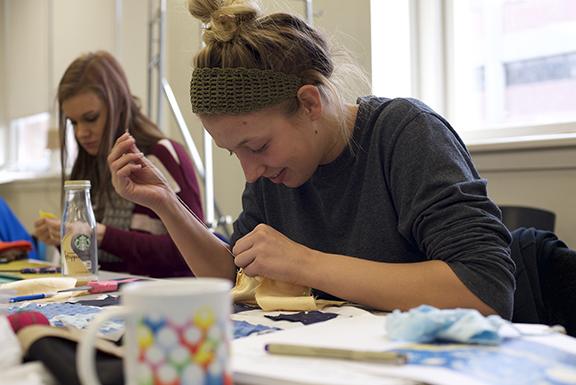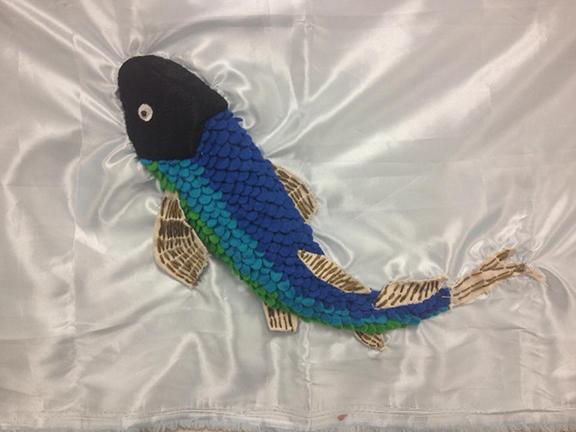
Students in Color and Composition class recreate famous artworks for visually impaired
calendar icon17 Dec 2014

The project challenged students to think about their art in a whole new manner.
“There are very basic design concepts like texture and line, as well as really maybe thinking about some aesthetic qualities like, ‘What does green feel like?’ that apply to this project,” Williams said. “There is so much of our world that is visual. The visual is a very big part of learning and processing the world around you, so what happens when you don’t have that?”
So much of our everyday visual vocabulary includes art.
“If you think about Mondrian’s ‘Broadway Boogie Woogie,’ everyone knows what that is. Everyone knows what ‘Persistence of Memory’ is or ‘Son of Man’ or ‘Scream,’” Williams said. “All you have to do is name those paintings, and everyone automatically has an association. So what happens when you’re left out of that? What my students are doing is very simple. They’re recreating these pieces almost as art quilts.”
Students could choose from a list of pieces to recreate or choose their own.
“The inherent challenges in this involved considering what the most important image from history is to them and how best to communicate that image,” Williams said. “They were really learning about those works of art in a different way, and there was a lot of reflection about art, context and agency.”
Audrey Graves, the NCECBVI Center-Based Program Principal, originally contacted Williams about the idea.
“The idea for this project first came after visiting the South Dakota School for the Blind. Their school had partnered with a local university on creating tactual pieces of art that were displayed throughout their campus,” Graves said. “I immediately fell in love with this idea and wanted to pursue a similar project to be displayed at NCECBVI as well.”
Williams and Graves met with Mackenzie Savaiano, Assistant Professor of Practice in Special Education and Communication Disorders in the College of Education and Human Sciences at UNL, to discuss access to art for people who are blind or visually impaired.
Graves and Savaiano also met with students in the class. The students used goggles and blindfolds that showed them what you see with various visual impairments.
“In the session, we worked in pairs and one of us wore a blindfold,” said Emily Tran, a sophomore studio art major from Vietnam. “Then, the other gave her partner a page in a book for the blind so that she could use her hands to figure out the image on the page. It’s not easy, but we had so much fun with each other.”
Samantha Greenfield, a junior in the College of Arts and Sciences, learned to appreciate texture.
“This project has obviously made me a lot more sensitive to the texture of art,” said Greenfield, who recreated Johannes Vermeer’s “Girl with a Pearl Earring” for her project. “We spent so much time running our hands over what we made, which almost never happens in other projects. In the future, I will be more conscious of other senses besides sight that are involved in viewing art.”
The students also visited the International Quilt Study Center and Museum on East Campus, where docent Mary Olshavsky gave them a tour and discussed how to describe something to the visually impaired.
“It challenged our vocabulary in a different way,” Williams said. “How do you describe a texture like shingled? Or blue? The students had great questions like how do we access our other senses? If there was a bowl of flowers on a quilt, you could talk about the smell of freshly cut flowers.”
The project made students think differently about their artistic choices.
“If you’re doing a Roy Lichtenstein piece, and he uses the Ben-Day dots, do you need to reinterpret those?” Williams said. “Visually he uses color separation to distinguish from bright red lips to pink skin. What do you prioritize? Is it essential to find a texture that has little raised dots? Is something else more essential? We’re going to find out.”
Tran recreated Ando Hiroshighe’s “Koi Fish,” but only after some trial and error.
“At first, I just focused on finding the appropriate textures for different parts of the painting,” Tran said. “However, after putting all the pieces of fabrics together, I realized that their colors didn’t get along with one another, which was totally unacceptable. It was really a big mistake, so I had to start all over again. Honestly, I did struggle a lot with materials and sewing techniques because I’m not really a domestic girl. I used satin for the water but it’s really difficult to work with this fabric because it is not stable. In order to make a realistic fish, I decided to sew the scales one by one. This process took me about 10 working hours to finish. It's time consuming but worthy.”
Elizabeth Johnson, a freshman studio art major from Lincoln, recreated Andy Warhol’s “Marilyn Monroe.”
“I think, for me, the hardest part was trying to find things that felt different and had different textures, so that you could tell the difference in the features,” Johnson said.
Kat Krutak-Bickert, a post-baccalaureate studio art student from Lincoln, recreated the Paleolithic “Woman of Willendorf,” a small statue (4.4 inches), which was created out of oolitic limestone between 28,000-25,000 BCE.
“The biggest struggle I had in the process was to create a two-dimensional piece from a three-dimensional object. I wanted the students to be able to feel the roundness of the female body, which the statue reflects,” Krutak-Bickert said. “’The Woman of Willendorf’ is one of the first images I remember studying during Art History. It was important to me that the students also get a chance to learn about some of the first forms of art throughout the world. It also challenged us to really think about how we interact with art and how using other senses such as touch and smell could be harnessed when creating our work.”
Lexi Trumbley, a junior studio art major from Lincoln, recreated a piece by European street artist Bansky. The piece has no formal title, but is often referred to as “Raining Color” and is a stencil and spray paint piece on the side of a building.
“My piece was especially difficult because the original medium was spray paint on the side of a building,” Trumbley said. “I picked a street art piece because it is a form of art that people with a visual impairment would not be able to experience in their daily lives. My challenge was creating a piece that had many different and rich textures in order to separate each individual color, while still staying true to the flatness of the original piece. I also wanted to make sure that even though the original had a lot of visual information to take in, I needed to simplify the piece in order for someone without sight to have enough space to feel each different aspect of the recreated work without it being too confusing.”
She said the project will influence her future projects.
“I’ve learned to be way more thoughtful in my color choices for any project,” Trumbley said. “This really made me question what colors felt like instead of just choosing them for solely aesthetic reasons.”
Allison Wetig, a sophomore studio art major from Omaha, said students were inspired to create these works.
“We had two workers from the School of the Blind come talk with us, and they showed us some books that had been made that contained printed texture,” said Wetig, who recreated Vincent van Gogh's "Starry Nights." “They told us that those books were really all the students had for art which made me much more motivated to create something beautiful and meaningful for them.”
Graves said creating access to the visual world for the visually impaired is crucial.
“A lot of art is visual, and when there are some tactual features, usually there is a ‘do not touch’ sign nearby,” she said. “People who are blind or visually impaired must have access to the world’s visual culture if they are to participate fully in their communities. Access to art can also improve quality of life and allow them to gain skills in the areas of education and employment opportunities.”
The students’ pieces will be on display at NCECBVI on Feb. 11 during the Braille Challenge, a national reading and writing challenge for students who are blind or visually impaired.
“After the students have completed the competition and are waiting on their scores, the art project will be unveiled,” Graves said. “We plan to have the students learn about this project and have a chance to experience these works of art.”
NCECBVI will celebrate its 140th anniversary on March 18, and the artwork will be showcased in this event as well and put on display at the school.
“The plan is to have the artwork exhibited throughout the school,” Graves said. “Along with the quilt, there will be a picture of the piece of art that has inspired the quilt, along with a description of the piece of art. I anticipate that the students will gain knowledge of popular works of art along with having the experience to explore it by reading about it along with feeling it. The artwork will not only be enjoyed by our students, but also anyone who visits our building throughout the year.”
Trumbley hopes their work is effective.
“I feel very nervous about my work being shown publicly, solely because we were the first people to try and take on the task of recreating artwork for the visually impaired not in a book format,” she said. “I really want this piece to be effective in letting people enjoy the artwork even though they can’t see it.”
Wetig is glad their work will get a public showing.
“I am really excited about that. This is a first for me,” she said. “I love that this piece isn’t just going in my closet or basement storage room like where the rest of my art usually ends up.”
Greenfield is also excited about displaying her work.
“As an artist, nothing is better than seeing others appreciate what you have made,” she said. “And the fact that this could be the beginning of a life-long love of art for the students is extremely gratifying.”
Williams said community service projects like this are to be valued.
“It’s important to integrate the arts into our everyday culture in a different way,” Williams said. “You’re connecting with a large group of people in a pro-social way.”
Graves hopes students continue to be influenced by this project in their future work.
“I hope that this group of artists will keep this experience in mind when creating artwork in the future,” she said. “This way they can create a variety of artwork that can be enjoyed by all, regardless of abilities or disabilities.”